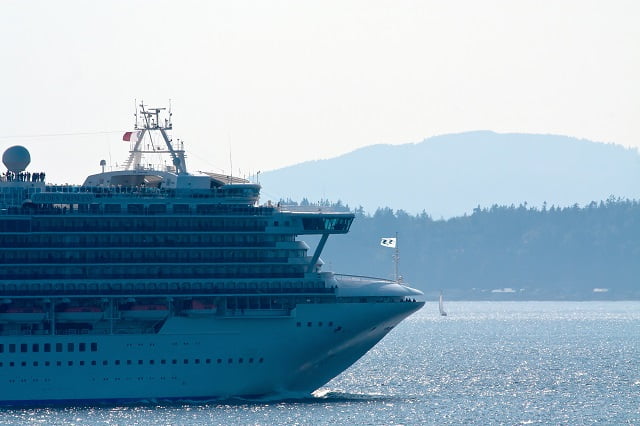Italy is renowned for its rich history, stunning landscapes, and iconic landmarks, making it a popular destination for travelers from around the world. One way to explore everything this beautiful country has to offer is through an Italy cruise. However, before embarking on this exciting adventure, it is essential to understand the visa requirements for Italy cruises.
Italy boasts a fascinating blend of ancient ruins, charming coastal towns, and vibrant cities, offering a diverse range of attractions and experiences for all types of travelers. From the historic wonders of Rome to the romantic canals of Venice and the artistic treasures of Florence, an Italy cruise allows visitors to immerse themselves in the country’s unique culture and beauty.
When planning an Italy cruise, it is important to be aware of the visa requirements for traveling to this European country. Visa regulations can vary depending on your nationality, length of stay, and purpose of visit. Understanding these requirements in advance will help ensure a smooth and hassle-free experience while exploring the wonders of Italy aboard a cruise ship.
In the following sections, we will delve deeper into the reasons why Italy is such a beloved cruise destination, discuss the different types of cruises available in Italy, and provide detailed information on visa requirements for those planning an Italy cruise. Whether you are dreaming of cruising along the Italian coast or exploring its picturesque lakes, this article will guide you through everything you need to know about visas for an unforgettable Italian adventure.
Italy as a Popular Cruise Destination
Italy is undeniably one of the most sought-after cruise destinations in the world, attracting millions of visitors each year. This beautiful country offers a wealth of experiences for cruise travelers, from its rich history and art treasures to its stunning landscapes and iconic landmarks. Whether you are a history buff, an art enthusiast, a food lover, or simply seeking a relaxing vacation, Italy has something for everyone.
One of the reasons Italy is such a popular cruise destination is because it offers a diverse range of experiences. From sailing through the sparkling waters of the Mediterranean Sea to exploring the charming coastal towns along the Amalfi Coast, there are numerous options for cruising in Italy.
Mediterranean cruises that include stops at famous Italian cities like Rome, Venice, and Florence are particularly popular. These itineraries allow travelers to experience the cultural wonders and historical sites that make Italy so special.
In addition to Mediterranean cruises, there are also cruises that explore the beautiful Adriatic Sea and even those that take you inland to explore Italy’s stunning lakes region. Regardless of which type of cruise you choose, you can expect breathtaking scenery, delicious cuisine, and unforgettable experiences along the way.
If you’re planning to embark on an Italy cruise adventure, it’s important to understand the visa requirements before setting sail. The next section will provide detailed information on visa requirements for Italy cruises and how to ensure a hassle-free travel experience.
Types of Italy Cruises Available
Italy offers a wide range of cruise options, allowing travelers to explore the beauty of this Mediterranean country from its stunning coastlines to its picturesque lakes. Whether you’re seeking a luxurious Mediterranean cruise, an adventure along the Adriatic Sea, or a tranquil journey on one of Italy’s famous lakes, there is a perfect Italy cruise for every type of traveler.
Mediterranean Cruises
- Mediterranean cruises are among the most popular types of Italy cruises. These cruises typically travel along the stunning coastlines of Italy and other Mediterranean countries, offering passengers the opportunity to visit iconic Italian cities such as Rome, Venice, and Florence. You can explore ancient ruins in Rome, wander the charming streets of Venice, and admire Renaissance art in Florence all in one unforgettable trip.
Adriatic Sea Cruises
- If you’re looking for a cruise that focuses specifically on exploring the Adriatic Sea and its coastal destinations, an Adriatic Sea cruise is a fantastic option. These cruises often depart from Venice and visit ports in Croatia, Montenegro, Greece, and Slovenia. You can discover historic cities like Dubrovnik and Split in Croatia or enjoy the breathtaking scenery of Montenegro’s Bay of Kotor.
Italian Lakes Cruises
- For those who prefer a more serene cruising experience, Italian lakes cruises are perfect for immersing yourself in nature while visiting some of Italy’s most beautiful lakes. Lake Como, Lake Garda, and Lake Maggiore are popular destinations for these cruises. Passengers can enjoy leisurely boat trips across peaceful waters surrounded by majestic mountains and charming lakeside towns.
No matter which type of Italy cruise you choose, you can expect incredible cuisine onboard featuring authentic Italian flavors paired with world-class service. Each type of cruise offers unique experiences and opportunities to explore different aspects of Italy’s rich culture and natural beauty. Whether you’re a history enthusiast, nature lover, or simply seeking a relaxing getaway, an Italy cruise is sure to provide an unforgettable journey.
Cruise Itineraries in Italy
Italy offers a wide range of cruise itineraries that allow travelers to experience the beauty and history of this stunning country. One popular itinerary is a cruise that stops at cities like Rome, Venice, Florence, Naples, and Sicily. These cities are all known for their rich culture, iconic landmarks, and delicious cuisine.
Starting in Rome, visitors can explore the ancient ruins of the Colosseum and the Roman Forum before indulging in some authentic Italian gelato. Venice, with its romantic canals and picturesque architecture, is another must-visit destination. Here, travelers can take a gondola ride through the winding waterways or visit famous sites like St. Mark’s Square and the Doge’s Palace.
Florence is known for its Renaissance art and architecture, with highlights including Michelangelo’s David at the Galleria dell’Accademia and the iconic Duomo. Naples offers a chance to explore the ruins of Pompeii or take a day trip to the beautiful island of Capri. Finally, Sicily provides an opportunity to visit charming towns such as Taormina or explore Mount Etna, Europe’s largest active volcano.
These itineraries provide a diverse mix of cultural experiences, historic sites, and natural beauty. Travelers on an Italy cruise can immerse themselves in Italy’s vibrant culture while enjoying luxurious accommodations on board their cruise ship.
While exploring these incredible cities may be exciting, it is important for travelers to also understand the visa requirements for entering Italy on a cruise. This will ensure that they have all necessary documents in order beforehand and avoid any issues during their trip. By familiarizing themselves with these requirements ahead of time and preparing accordingly, travelers can enjoy their Italy cruise without any hassle or stress.
Understanding Schengen Visa
The Schengen Visa is an essential aspect to understand when it comes to Italy cruises. As a cruise destination within the Schengen Area, Italy has specific visa requirements for travelers from certain countries. Understanding what the Schengen Visa is, its purpose, and how it relates to Italy cruises is crucial for smooth travel arrangements.
The Schengen Visa is a short-stay visa that allows travelers to visit any of the 26 countries in the Schengen Area for up to 90 days within a 180-day period. These countries include popular tourist destinations such as France, Spain, Greece, Germany, and Italy. Therefore, if you plan on embarking on an Italy cruise that includes stops at other countries within the Schengen Area, it is important to obtain a Schengen Visa.
The purpose of the Schengen Visa is to facilitate free movement within the participating countries while maintaining strict border control policies and security measures. It eliminates the need for multiple visas when traveling between these countries and allows travelers to explore various destinations seamlessly. When it comes to Italy cruises, having a Schengen Visa enables passengers to visit different ports without worrying about individual visa requirements for each country.
| Key Information | Details |
|---|---|
| Schengen Area Countries | 26 countries (including Italy) |
| Maximum Stay | 90 days within a 180-day period |
| Purpose of the Visa | Facilitating free movement in participating countries while maintaining border control and security measures |
It is important to note that not all travelers require a Schengen Visa for Italy cruises. Citizens of certain countries, such as the European Union member states, do not need a visa to enter the Schengen Area. Additionally, some non-EU countries have visa-free agreements with the Schengen Area. However, it is essential to research individual circumstances and nationality-specific requirements before embarking on an Italy cruise.
Understanding the Schengen Visa and its relevance to Italy cruises is crucial for a hassle-free travel experience. By obtaining the necessary visa and complying with the regulations, passengers can enjoy their cruise without any unnecessary complications or stress. The next section will provide detailed information on the specific visa requirements for Italy cruises, including who needs a visa, what documents are needed, and how to apply.
Visa Requirements for Italy Cruises
Italy is a popular destination for cruises due to its rich history, stunning scenery, and iconic landmarks. However, before embarking on an Italy cruise, it is important to understand the visa requirements.
The main visa requirement for Italy cruises is the Schengen Visa. The Schengen area is a group of 26 European countries that have agreed to allow free movement of their citizens within this area as a single country. This means that a Schengen Visa allows travelers to visit any of these countries, including Italy, for up to 90 days within a six-month period.
To apply for a Schengen Visa for an Italy cruise, certain documents are needed. These include a valid passport with at least two blank pages and three months validity beyond the planned departure from the Schengen area. Proof of travel insurance coverage with a minimum of €30,000 in medical expenses coverage is also required.
Additionally, applicants will need to provide proof of accommodation for their stay in Italy or the Schengen area, such as hotel reservations or a letter of invitation from a host in Italy. It is also necessary to show proof of sufficient funds to cover the expenses during the stay, such as bank statements or credit card statements.
Applying for a travel visa can be a complex process. It is recommended to start the application process well in advance of the planned trip and seek professional guidance if needed. Ensuring that all necessary documents are gathered and filled out correctly will help minimize any delays or issues during the application process.
Overall, understanding the visa requirements for Italy cruises is crucial to ensure a hassle-free experience. By being well-informed and properly prepared with all necessary documents, travelers can enjoy their cruise without any visa-related concerns.
| Visa Requirements | Documents Needed |
|---|---|
| Valid Passport | Passport with at least two blank pages and three months validity beyond the planned departure from the Schengen area |
| Travel Insurance Coverage | Proof of travel insurance coverage with a minimum of €30,000 in medical expenses coverage |
| Proof of Accommodation | Proof of accommodation for the stay in Italy or the Schengen area, such as hotel reservations or a letter of invitation from a host in Italy |
| Sufficient Funds | Proof of sufficient funds to cover expenses during the stay, such as bank statements or credit card statements |
Exemptions and Visa-Free Entry Options
When it comes to visa requirements for Italy cruises, there are certain exemptions and visa-free entry options available for travelers. It’s crucial to understand these exemptions and options based on individual circumstances, as they can greatly impact the planning process and overall travel experience. In this section, we will explore some of the exemptions and visa-free entry options that travelers should be aware of.
Exemptions
Certain nationalities may be exempt from needing a visa for an Italy cruise. These exemptions are often based on agreements between Italy and specific countries.
For example, citizens of the European Union member states, as well as those from the European Economic Area (EEA) and Switzerland, do not require a visa to enter Italy or embark on an Italy cruise. Additionally, nationals of some other countries may also be exempt from obtaining a visa for tourism purposes for a limited duration.
It’s important for travelers to check with the relevant embassy or consulate to confirm if they are exempt from requiring a visa for their Italy cruise.
Visa-Free Entry Options
In addition to exemptions, there are also certain visa-free entry options available for travelers visiting Italy on a cruise. One such option is the Schengen Visa. The Schengen Visa allows travelers to visit multiple countries within the Schengen area without having to apply for separate visas for each individual country.
If you already hold a valid Schengen Visa, you would not need an additional visa specifically for your Italy cruise as long as your trip aligns with the validity dates of your existing Schengen Visa.
It’s important to note that even if you have an exemption or qualify for a visa-free entry option, it’s still important to carry all required documentation with you when boarding your cruise ship. This includes valid passports, evidence of onward travel arrangements, proof of sufficient financial means, and any other supporting documents that may be required.
Understanding these exemptions and visa-free entry options can help save time, money, and unnecessary hassles during the planning process of an Italy cruise. It’s important for travelers to research their individual circumstances and consult with the relevant authorities or immigration offices for the most up-to-date information on visa requirements. By doing so, travelers can enjoy a stress-free and smooth sailing experience while exploring the beautiful country of Italy.
Applying for a Travel Visa for Italy Cruise
When planning an Italy cruise, it is essential to understand the visa requirements and application process. To ensure a hassle-free travel experience, it is crucial to gather all the necessary documents, correctly fill out application forms, and submit everything in a timely manner. This section will guide you through the step-by-step process of applying for a travel visa for an Italy cruise.
Gather Necessary Documents
Before starting the visa application process, it is important to gather all the necessary documents. These typically include a valid passport with at least six months of validity beyond the planned departure date, recent passport-sized photographs, proof of travel insurance coverage for the duration of your trip, and round-trip flight or cruise reservations.
Additionally, you may be required to provide documentation proving your financial stability and demonstrating that you have sufficient funds to support yourself during your stay in Italy. This can include bank statements or evidence of employment and income.
Filling Out Application Forms
The next step in applying for a travel visa for an Italy cruise is filling out the application forms. The specific forms required may vary depending on your country of residence and nationality. It is crucial to carefully read and follow all instructions provided by the Italian Embassy or Consulate.
It is important to answer all questions accurately and truthfully when completing the application forms. Double-checking your answers and proofreading before submitting can help minimize errors and avoid delays in processing your visa application.
Submitting the Application
Once all the necessary documents have been gathered and the application form has been completed, you will need to submit your visa application. The submission process also varies depending on the country from which you are applying.
In some cases, you may be required to schedule an appointment at the Italian Embassy or Consulate in your home country. During this appointment, you will submit your documentation and the visa application, and you may be required to provide biometric data such as fingerprints.
In other cases, you may be able to submit your application by mail or through an authorized visa processing center. It is important to verify the specific submission process for your country of residence.
Tips for a Smooth Visa Application Process
Applying for a travel visa for an Italy cruise can sometimes be a complex process, but with the right preparation and organization, it can be made much smoother. Here are some tips to help you navigate the visa application process with ease.
First and foremost, it is crucial to plan ahead and give yourself ample time to gather all the necessary documents and submit your application. Visa processing times can vary, so it is best not to leave things until the last minute. Start by checking the official website of the Italian embassy or consulate in your country to understand the specific requirements for your nationality.
Seeking professional guidance can also be beneficial, especially if you are unfamiliar with the visa application process or have specific circumstances that may require additional documentation. Immigration consultants or visa agencies can provide expert advice and guidance throughout the application process, ensuring that you submit a complete and accurate application.
One of the most essential aspects of a smooth visa application is making sure that all your documents are in order. This includes having a valid passport with at least three months of validity beyond your planned departure from Italy. Additionally, you will need to provide proof of travel insurance coverage, proof of accommodation for your stay in Italy, a detailed itinerary of your cruise activities, and evidence of sufficient funds to support yourself during your trip.
When filling out the visa application form, carefully read and follow all instructions provided by the embassy or consulate. Make sure to provide all requested information accurately and honestly. It is also advisable to double-check that you have completed every section before submitting your application.
Lastly, maintaining open communication with the embassy or consulate throughout the visa application process can help resolve any potential issues or delays promptly. If there are any changes to your travel plans after you have submitted your application, it is essential to inform them immediately.
By following these tips and being proactive in preparing for your visa application, you can significantly increase your chances of obtaining a travel visa smoothly and hassle-free. With all the necessary documentation in order, you can look forward to enjoying your Italy cruise with peace of mind and excitement.
Conclusion
In conclusion, it is crucial to be well-informed about visa requirements when embarking on an Italy cruise. As one of the most popular cruise destinations in the world, Italy offers a mesmerizing blend of history, culture, and stunning landscapes that attract travelers from all over. From Mediterranean cruises to Italian lakes cruises, there are a variety of options for every type of traveler.
Understanding the Schengen Visa and its relation to Italy cruises is essential. The Schengen Visa allows visitors to travel freely within the 26 European countries that are part of the Schengen Area, including Italy. Depending on your nationality, you may need to apply for a Schengen Visa before your trip. It is important to gather all necessary documents and follow the application process step-by-step to ensure a smooth visa experience.
Researching exemptions or visa-free entry options for certain nationalities traveling on Italy cruises can save you time and money. Some countries have agreements with Italy that allow their citizens to enter without a visa or have specific conditions for entry. It is crucial to verify your specific circumstances and carefully review the requirements.
By following these tips and properly preparing for your visa application, you can enjoy an Italy cruise hassle-free. Planning ahead, seeking professional guidance if needed, and ensuring all necessary documents are in order will contribute to a seamless experience. With proper knowledge about visa requirements for Italy cruises, you can fully immerse yourself in the wonders of this beautiful country while sailing through its enchanting waters.
Frequently Asked Questions
Do I need a visa to go to Italy for a cruise?
Whether or not you need a visa to go to Italy for a cruise depends on your nationality. Citizens of some countries, such as the United States, Canada, Australia, and Japan, do not require a visa for visits to Italy that last up to 90 days for tourism purposes.
However, it is always important to check the specific requirements based on your country of origin and the duration of your stay. If you plan to extend your stay in Italy before or after the cruise, you might need to obtain a visa.
Do cruise passengers need a visa?
Generally speaking, cruise passengers do not need a visa for the countries they visit during their cruise if their stay is limited to the duration of the cruise activities. When passengers participate in shore excursions organized by the cruise line and remain with organized groups during their time ashore, they are usually covered under a “cruise ship passport” which is essentially an agreement between the authorities of certain countries and cruise lines that allows passengers to enter without obtaining an individual visitor’s visa.
However, it’s essential to confirm this information with both the cruise line and relevant authorities for each specific destination on your itinerary.
Do I need a visa for European cruise?
For European cruises, whether or not you need a visa depends on your nationality and which countries you’ll be visiting during the cruise. As mentioned earlier, citizens of some countries typically do not require visas for short stays in most European countries if they are there for tourism purposes only.
However, if your itinerary includes non-Schengen countries like Croatia or Turkey along with Schengen area countries like Italy or Greece, additional visa requirements may apply. It is crucial to carefully review each destination’s entry requirements and consult with relevant embassies or consulates well in advance of your travel dates to ensure compliance with immigration regulations.

I’m a passionate traveler, writer, and Italophile. My fascination with Italy’s history, art, and culture has led me on countless adventures across the Italian landscape. Through “I Live Italy,” I share my love for this extraordinary country and aims to inspire others to explore its boundless beauty.





